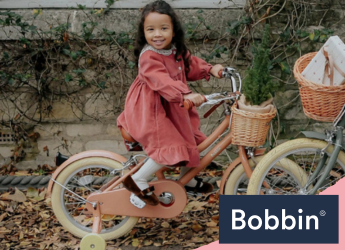Where Is the Best Place for Kids to Learn to Cycle?
Learning to bike ride is a monumental step in a child’s life. Beyond the physical act of pedalling, it symbolises a leap towards independence. However, this journey begins with a crucial decision: where is the best place for kids to learn to cycle?
The choice of location can shape their cycling experience. Whether it’s from the safety of empty parking lots to adventurous bike paths, you name it.
So in this blog, we’ll explore various options and factors to find the perfect pedalling ground. Read on and discover which one works for your little one and their Bobbin kids bike!
Safety First
Safety stands as the foremost concern when selecting a spot for kids to learn cycling. Opt for a flat, even surface, crucial to reducing the risk of accidents. Minimal traffic and potential hazards are paramount to ensure a secure environment.
Equip your young cyclist with protective gear. This includes a quality Bobbin bike helmet and knee and elbow guards.
Never underestimate the significance of consistent parental supervision! This guarantees a safe and confidence-building learning experience.
1. Empty parking lots
Empty parking lots emerge as prime spots for introducing kids to cycling - with balance bikes, for one. They offer ample space, granting fledgling cyclists the freedom to navigate without constraint.
With no traffic to deal with, young riders can focus on mastering their balance and steering. The smooth surfaces of parking lots also provide a stable foundation. This layout helps minimise the risk of sudden jolts or bumps. Perfect for teaching a child to ride a bike with stabilisers!
To find a suitable lot, scout local areas during quieter hours or weekends. Optimal times for practice include early mornings or late afternoons.
2. Parks and recreation areas
Parks and recreation areas present a delightful backdrop for children’s cycling initiation. The allure lies in the joy of pedalling amid nature’s embrace. Riding through open spaces and gentle trails fosters adventure and freedom, to add.
These settings also offer more than just cycling on their bikes with stabilisers. Breaks can be transformed into picnics or explorations of playgrounds. A great way to introduce a playful balance between practice and leisure.
With a refreshing breeze, parks become not only a training ground. But also a cherished memory-making realm for kids taking their first spins on two wheels!
3. Residential streets
Quiet residential streets offer a strategic stepping stone for young cyclists. Their serene environment allows children to refine their cycling skills. Beginning on these streets helps build confidence in steering, braking, and manoeuvring. Such skills pave the way for smoother transitions to busier roads.
As a budding cyclist, it’s important to introduce them to basic road rules and safety measures. Take this bicycle lane rules guide, for instance. This prepares them for more complex cycling scenarios. Great examples are navigating intersections and crossings with heightened awareness. And, of course, taking advantage of their ding-dong companions, a.k.a. bike bells, to alert others to their presence.
By leveraging the advantages of residential streets, parents foster both skills and awareness. This, in return, shapes their child’s cycling journey with safety and competence in mind.
4. Bike paths and trails
Bike paths and trails serve as an exhilarating playground for young riders. Beyond honing skills, these paths ignite a sense of adventure and discovery. The designated routes ensure a secure environment, allowing children to pedal with confidence.
Once mastered, these paths offer a thrilling transition to longer rides. This encourages children to develop endurance on their hornet bikes with self-assurance. Bonus: The promise of scenic landscapes adds a layer of excitement to the learning process.
5. Backyard and driveway
Utilising your backyard or driveway as a practice ground offers unparalleled convenience. Within the safety of home, children can pedal freely without concerns about traffic. And with or without the aid of stabilisers.
Adding simple obstacles or markers hones their control and balance skills. This setup also eliminates transportation requirements, granting the luxury of frequent practice sessions. The comfort of familiar surroundings encourages children to learn at their own pace.
With each spin of the wheels, their confidence grows, and mastery inches closer. And the last thing you know, you’re preparing them for this: Off-road Trail Tips for Adventurous Kids.
Round-up
In the quest for the perfect place to teach kids to cycle, safety and the environment intertwine. Moreover, the road to cycling mastery is built upon safety, guidance, and exploration. But remember, it’s not just about the location. It’s the journey that moulds them into skilful riders ready to explore the world on two wheels!
Bobbin presents an impressive array of kids bicycles and bike accessories. Make sure to check them out! What you should read next: At What Age Can a Child Ride a Bike Without Stabilisers?














